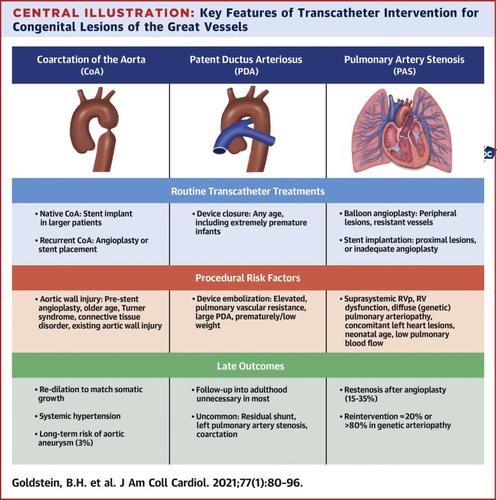当前位置:
X-MOL 学术
›
J. Am. Coll. Cardiol.
›
论文详情
Our official English website, www.x-mol.net, welcomes your feedback! (Note: you will need to create a separate account there.)
Transcatheter Intervention for Congenital Defects Involving the Great Vessels
Journal of the American College of Cardiology ( IF 24.0 ) Pub Date : 2021-01-01 , DOI: 10.1016/j.jacc.2020.11.019 Bryan H. Goldstein , Jacqueline Kreutzer
Journal of the American College of Cardiology ( IF 24.0 ) Pub Date : 2021-01-01 , DOI: 10.1016/j.jacc.2020.11.019 Bryan H. Goldstein , Jacqueline Kreutzer

|
Since the development of balloon angioplasty and balloon-expandable endovascular stent technology in the 1970s and 1980s, percutaneous transcatheter intervention has emerged as a mainstay of therapy for congenital heart disease (CHD) lesions throughout the systemic and pulmonary vascular beds. Congenital lesions of the great vessels, including the aorta, pulmonary arteries, and patent ductus arteriosus, are each amenable to transcatheter intervention throughout the lifespan, from neonate to adult. In many cases, on-label devices now exist to facilitate these therapies. In this review, we seek to describe the contemporary approach to and outcomes from transcatheter management of major CHD lesions of the great vessels, with a focus on coarctation of the aorta, single- or multiple-branch pulmonary artery stenoses, and persistent patent ductus arteriosus. We further comment on the future of transcatheter therapies for these CHD lesions.
中文翻译:

涉及大血管的先天性缺陷的经导管干预
自 1970 年代和 1980 年代球囊血管成形术和球囊扩张血管内支架技术的发展以来,经皮经导管介入已成为治疗先天性心脏病 (CHD) 全身和肺血管床病变的主要手段。大血管的先天性病变,包括主动脉、肺动脉和动脉导管未闭,在从新生儿到成人的整个生命周期中都可以接受经导管干预。在许多情况下,现在存在标签上的设备来促进这些治疗。在这篇综述中,我们试图描述大血管主要 CHD 病变经导管治疗的现代方法和结果,重点是主动脉缩窄、单分支或多分支肺动脉狭窄、和持续性动脉导管未闭。我们进一步评论了这些 CHD 病变经导管治疗的未来。
更新日期:2021-01-01
中文翻译:

涉及大血管的先天性缺陷的经导管干预
自 1970 年代和 1980 年代球囊血管成形术和球囊扩张血管内支架技术的发展以来,经皮经导管介入已成为治疗先天性心脏病 (CHD) 全身和肺血管床病变的主要手段。大血管的先天性病变,包括主动脉、肺动脉和动脉导管未闭,在从新生儿到成人的整个生命周期中都可以接受经导管干预。在许多情况下,现在存在标签上的设备来促进这些治疗。在这篇综述中,我们试图描述大血管主要 CHD 病变经导管治疗的现代方法和结果,重点是主动脉缩窄、单分支或多分支肺动脉狭窄、和持续性动脉导管未闭。我们进一步评论了这些 CHD 病变经导管治疗的未来。


























 京公网安备 11010802027423号
京公网安备 11010802027423号